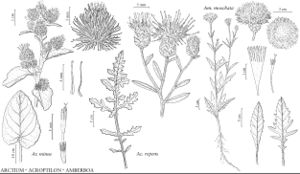Amberboa
Syn. Gen. Compos., 8. 1832.
| Taxon | Illustrator ⠉ | |
|---|---|---|
 | Arctium minus Acroptilon repens Amberboa moschata | John Myers John Myers John Myers |
Annuals or biennials, 20–70 cm; herbage not prickly, glabrate. Stems erect, usually branched from near bases. Leaves basal and cauline (distal smaller); petiolate (basal and proximal cauline) or sessile (distal cauline); blade margins dentate or ± lobed (basal) or entire to lobed (cauline). Heads ± radiant, borne singly. (Peduncles slender.) Involucres ovoid, 12–16 mm diam. Phyllaries many in several series, bases appressed, margins scarious, apices obtuse, inner with oblong, scarious appendages, these entire or spiny. Receptacles flat, epaleate, bearing setiform scales (“flattened bristles”). Florets many; corollas white to pink, purple, or yellow; outer sterile, corollas expanded, raylike, bilateral, 5–many-lobed; inner fertile, corollas actinomorphic; anther bases tailed, apical appendages oblong; styles branches: fused portions with basal nodes minutely hairy, distinct portions minute. Cypselae oblong, compressed, (apices denticulate), faces ribbed, wrinkled, with long, ascending hairs, basal attachment scars lateral, surrounded by whitish, swollen rims; pappi persistent, of many scales in several series, distinct, narrow [rarely 0]. x = 16.
Distribution
Introduced; Mediterranean region to c Asia
Discussion
Species 6 (1 in the flora).
Amberboa has often been included within Centaurea, from which it differs by cypselae each with a denticulate apex and a conspicuous rim around the basal scar. The chromosome base number x = 16 is higher than that in most species of Centaurea in a strict sense. Molecular phylogenetic studies of the relationships of Cynareae genera (A. Susanna et al. 1995) place Amberboa as sister to the remaining genera of the Centaureinae.
Selected References
Lower Taxa
"fine" is not a number.